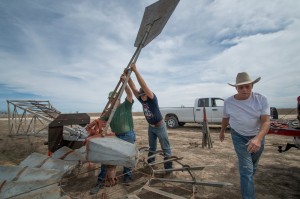The most recent USDA census survey, done in 2007, actually showed an 8 percent increase in the number of farm and ranch operations in Texas compared to a decade earlier.
The acreage devoted to farming and ranching, however, is shrinking, as Texas ranchland continues to be gobbled up by urban sprawl and highway projects. In other words, farms and ranches are increasing in number but shrinking in size.
In 1997 the average agricultural operation consisted of 585 acres. Ten years later, it was 527 acres. Mammoth places such as the 825,000-acre King Ranch get a lot of attention in Texas, but half of the state’s farms and ranches are smaller than 100 acres.

In times of drought, mega-ranches such as the Bonds Ranch are able to move their cattle to pastures in other areas of the state or across state lines to places where rain is more abundant. They can cull out more cows while still maintaining their core herds, putting them in a good position to rebuild quickly.
Small ranchers tend to scale back their herds and rely on hay and grain to supplement any grass they have. Many hobbyist ranchers have other sources of income to rely on, such as jobs in town or pensions.
“Most of the people I know are hanging on,” said Texas Farm Bureau spokesman Gene Hall.
Anyone whose income is derived solely from ranching is hurting these days, and mid-size ranches of 500 to 2,000 acres are particularly feeling the squeeze.
If those ranchers don’t have grass to feed their cattle, don’t have other ranches to move them to, and can’t afford grain and hay to feed a large number of cows, they have to sell their herds. That puts them in a bind the next year when they don’t have mama cows giving birth to calves.
“Any reduction of income to that size operation is immediately felt,” White said.
Natural gas drilling, hunting leases, and selling off parcels of land for development have helped many ranchers persevere. Drilling rigs and compressor stations are as common as water tanks and salt licks on many North Texas ranches.
“I didn’t know ranching was so goddamn easy,” Bonds said with a laugh on a recent morning as we drove past several drilling sites on his property.
He was joking. There is little easy about ranching. But it’s clear that he and other ranchers appreciate extra income when they can get it. And even as Bonds is expanding his ranching operations to rural areas across the country, he’s also selling off his Saginaw ranch a little at a time for residential development. He’s sold about 1,000 acres in recent years. Driving from one section of his ranch to another these days involves dodging suburbia.
“Land goes to the highest and best use eventually,” Bonds said.
Despite urbanization and sprawl, Texas still has about 100 million acres of rangeland.
“We’ve got a lot of land and grass, and we’re going to keep having cows,” Anderson, the livestock economist, said. “And we like eating beef, whether it’s steak or hamburger. When people want to go out, particularly when they’re celebrating some event in their life, they go have a steak. They don’t go looking for a piece of chicken.”
Texans who raise cattle for a living aren’t exactly pushovers. Many are descendants of pioneers who came to this hardscrabble state and carved out a living from dirt, rocks, mesquite, and cactus.
“They don’t quit easy,” Hall said. “It’s been a tough three or four years, but there is going to be ranching and cattle in Texas longer than I’ll be in Texas, and I’m going to be in Texas until I die.”
And no place takes more pride in its cattle culture than Fort Worth, even though the only bovines being herded through town these days are the Longhorn steers that entertain tourists in the Stockyards.
********
When cattle ranchers suffer in Texas, so do a lot of associated industries and the towns and cities where they’re located.
Cantrell’s normally rosy crystal ball, for instance, isn’t inspiring much optimism in the 80-year-old cattleman these days. He sounds like a realist when describing how his auction house used to sell 500 to 1,000 head of cattle a week but now moves half that many.
“The cattle are not out there. They’re gone,” he said.
Several part-time workers who used to help out during auctions are gone as well.
“We’ve had to lay some off,” he said. “We need to lay some more off, probably, and will have to later if things don’t change.”
He isn’t the only one cutting staff. A major beef processor, Cargill Inc., recently shut down its plant in Plainview due to low beef supplies. About 2,300 people — or 10 percent of the townsfolk — worked there. In some families, several generations of relatives relied on the West Texas plant for their livelihoods. Now those families are splitting up as they look for new jobs in other towns.
Cargill isn’t officially closing. Executives say they are just idling the plant until cattle supplies come back. When that will happen is anybody’s guess.
Fort Worth still calls itself “Cowtown,” although its role in the cattle industry these days is minimal. Cowboys used to stop here for supplies, booze, and a chance to tarry with women on their way north on cattle drives.
After the railroads arrived, Fort Worth became a major shipping hub for cattle. The Livestock Exchange Building was built in 1902 to house the various support businesses, and it soon earned the nickname “the Wall Street of the West.” More than 5 million head of cattle were processed in 1944.
But highway system improvements and the growth of the trucking industry helped to spell doom for the Stockyards. The Swift and Armour meat packing plants that once processed hundreds of thousands of cattle, hogs, and sheep each year went quiet decades ago — Armour in 1962 and Swift in 1971.
“As far as control of markets, Fort Worth is nothing like it used to be,” Bonds said.
Still, the city can claim its Cowtown nickname without too much shame.
The annual stock show draws a million people a year. The Stockyards still hosts special-breed cattle auctions and a weekly rodeo. Cattle are sold through video auctions at the Exchange Building. Local brokerage firms still handle cattle contracts.
And Fort Worth continues to cherish its past and its Cowtown image.
That’s why the Texas and Southwestern Cattle Raisers Association is still headquartered here and holds its annual convention here.
“I’ve talked to our members about having our convention in other cities but they say ‘No, we like coming to Fort Worth — it’s more fun.’ They like walking around town in their boots and hats and not feeling out of place,” said association CEO White.
About 3,000 ranchers are expected to hit Fort Worth on March 22 and 23 for the association’s 136th annual convention.
“From our industry’s perspective, we still see it as a hub for the cattle industry, not only in Texas but in the country,” White said. “Fort Worth takes pride in the origins that created this great town. I’ve lived in Kansas City and Denver, and you don’t see any remnants of the history that they shared with Fort Worth. But Fort Worth embraces it.”
The weather forecast for that weekend calls for a chance of rain.











